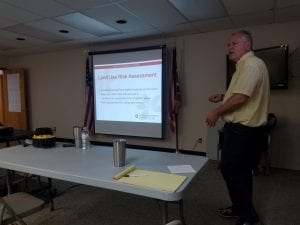

To register for training classes contact the Pesticide Safety Education Team at 614-292-4070 or pested@osu.edu. The cost for a morning session is $35 and the afternoon session is $30. All classes will be held at Ohio Department of Agriculture, Bromfield Administration Building 8995 East Main St. Reynoldsburg, OH 43068. More information can be found below and on the attached pictures.
NEW PESTICIDE APPLICATOR TRAINING CLASSES
(Core and Categories 5, 6c, 8)
This training program provides an overview of pesticide safety information. Everyone attending the morning session will receive documentation that they have met the requirements of Trained Serviceperson training. A Trained Serviceperson can apply pesticides in Ohio as long as they are working under the supervision of a licensed commercial applicator. The afternoon sessions will review Ornamental Weed Control (Category 6c). Attendees will choose between Industrial Vegetation (Category 5) and Turf (Category 8).
Testing is available at the conclusion of the day. A photo ID is required for the test.
Registration and check in opens at 8:30 a.m. The class begins at 9:00 a.m. The class fees include a continental breakfast, instruction, and class notes. Lunch is included with pre-registration. To receive study materials for the class, you must apply for a license with the Ohio Department of Agriculture, which requires a separate $35 fee. Signing up for this class will not deliver you study materials.
On-site registration accepts cash and check ONLY. No credit cards can be used for on-site registration.
Refunds and Cancellations: There will be a $25 processing charge per registrant for any refunds. No refunds will be given after two weeks following the class. There is a $30 fee for any returned checks.
Registration and check in begins at 8:30 a.m. Below is the class schedule. Exams are available at the conclusion of the class, around 3:30 p.m. You will choose what exams you would like to take during the check-in process at the beginning of the day. Attendees that attend the morning session will receive a Trained Serviceperson certificate.
| 9:00 Morning Session |
| Core and Trained Serviceperson Review |
| Laws and Regulations |
Applicator Safety and Environment |
| Calculations and Formulations |
Label Interpretation and Quiz |
| Lunch: 12:15 p.m. – 1:00 p.m. |
| 1:00 p.m. Afternoon Session |
| Weed and Herbicide Basics |
| Weed control principless and herbicide terminology for: |
| Ornamental Weed (6c) |
Industrial Vegetation (5) |
| Turf (8) |
|
| 2:10 Breakout Sessions |
Turf (8)
Auditorium |
Industrial Vegetation (5)
Seminar Room A |
| Turf Insects |
Applications and Calculations |
| Turf Disesease |
Label Reading |
|
Noxious Weed ID |
License and Study Materials
The New Applicator Pesticide Training course is designed to help you prepare for the Commercial Pesticide Applicator test. To become licensed, you must apply for your license with the Ohio Department of Agriculture.
The application for a pesticide license requires a separate $35 fee be paid to the Ohio Department of Agriculture. Once you have applied for your license, you will receive study materials. It can take 4-6 weeks to receive your study materials. We recommend that you apply for your license before taking this course. A representative from the ODA will be available on site to distribute study materials, if you have not yet received them.
You must pass the core test and at least one category test to receive your license.























